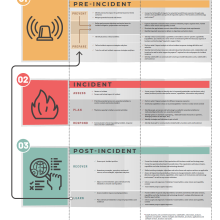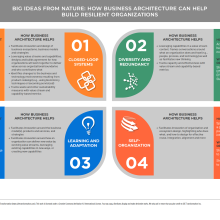We’ve covered incident preparation, response, and recovery,* so now we will turn our focus to resilience.
*Here’s a handy diagram that summarizes everything we’ve covered so far:
The unexpected happens. Expect the unexpected. The question in our ever-changing world is, how we can build organizations that are resilient and adaptable? We will explore this question using our most brilliant teacher as our guide: nature.
So, what is resilience, really?
Resilience is “the capacity of a system, be it an individual, a forest, a city or an economy, to deal with change and continue to develop.” (Source Stockholm Resilience Centre).
Resilience is about continuing to operate, evolving, and moving forward relentlessly.
What can we learn about resilience from our natural world?
Nature has one important goal: to keep its operations running, so that life can continue indefinitely. To do so, resilience is not optional. And nature is resilient in brilliant ways that are beyond our full comprehension.
While it only scratches the surface, we will explore four big ideas for how nature achieves resilience.
- (1) Closed-Loop Systems – The idea of a closed-loop system is that there is no concept of waste. Everything can be used and becomes “food” for something else. Basically, waste = food. For example, let’s think about a forest. Plants and trees use energy from an unlimited energy source (the sun), and they use nutrients and water from the soil. They also consume carbon dioxide and release oxygen. Animals eat those plants, consume oxygen and release carbon dioxide for the plants. When the plants and animals die, they decompose into nutrients that return to the soil and it all begins again. From a resilience perspective, a natural and closed-loop system based is a great way to ensure your supply chain.
- (2) Diversity and Redundancy – Nature achieves stability and health through diversity, not uniformity. In Nature banks on diversity – uniformity is a risk to the goal of continuing life. For example, let’s think about the human immune system. It cleverly uses redundancy by having millions of copies of leukocytes (white blood cells) before they are actually needed, to create a massive buffer against the unexpected. And, it cleverly leverages diversity by having not just leukocytes but many different types of cells. This diversity can deal with a wide range of invaders to the body that it hasn’t even encountered before. The immune system is a powerhouse of adaptability and resilience.
- (3) Learning and Adaptation – Nature adjusts to the environment to improve the chance of survival. Organisms can adapt to their environments biologically or structurally, meaning they alter their body functions such as when people who live at high altitudes can function with lower levels of oxygen. Or, they can adapt their behavior, such as penguins that crowd together to share warmth.
- (4) Self-Organization – Self-organization is “spontaneous creation of a globally coherent pattern out of local interactions.” (Source: The Science of Self Organization and Adaptivity) In our human-made world, we often create things which are complicated, with many small parts, all different with their own precise role in a machine or system. However, nature is not complicated. Nature is complex, which means that its systems are made of many similar parts and their interaction produces coherent behavior where the whole is greater than the sum of the parts. For example, let’s think about a school of fish or a formation of birds flying. There are good reasons for this behavior such as avoiding predators and creating efficiency. In cases like these, there is not necessarily a fish executive or bird boss tells the others what to do, but rather each organism follows a set of simple rules that produce emergent properties that can’t be predicted from the individual rules. The result is greater than the sum of its parts. A principle of self-organization is that there is an absence of centralized control. This leads to resilience by creating a redundant distributed organization, so in the case of the unexpected, one part of the organization can make up for another.
Cool ideas. How can organizations put them into practice?
Here are a few ways organizations can and have leveraged these big ideas.
- (1) Closed-Loop Systems – The opportunity for organizations is to shift the model from linear to circular. Our current model in business is generally linear. We take > make > waste. For example, we cut down trees, turn them into wood pulp, make paper, use paper and much of it may end up in a landfill. An excellent example of applying this closed-loop concept to business is industrial ecology or industrial symbiosis. This is where separate organizations decide to work together and the outputs of one organization become the inputs of another. Check out this amazing story about the Kalundborg industrial ecosystem where multiple public and private organizations work together and exchange 25 different resource streams. For example, some organizations produce waste heat which goes to a greenhouse and district heating, while excess steam produced goes to a biotech facility.
- (2) Diversity and Redundancy – The opportunity for organizations is to shift from a narrow focus on efficiency to focusing on effectiveness and having some slack in the system. Having some slack in the system is not just valuable to prepare for the unexpected, but also for other business benefits such as giving employees time to serve customers in unexpected ways. Here’s a recent example of how 3M used its surge capacity and localized supply chains to increase the production of masks needed for the pandemic.
- (3) Learning and Adaptation – The opportunity for organizations is to shift from attempting to control predictability to leveraging the unexpected. This means not just adapting to survive, but to thrive by leveraging challenges to create new opportunities. Here’s a recent example of how Canlis, a fine-dining restaurant reimagined their business model during the pandemic and began offering bagels, drive-thru burgers and a family meal delivery service. This adaptation has not only kept the business running but has probably increased their customer loyalty and brand recognition.
- (4) Self-Organization – The opportunity for organizations is to shift from complicated to complex – and from focusing on parts to focusing on the entire system. This is important for resilience because when products, machines, organizations, or systems are complicated, they are more likely to fail when something unexpected occurs. There are examples of organizations that are adopting principles of self-management, wholeness and an evolutionary purpose, as described in The Future of Management is Teal. One common misconception about self-management is that everyone is equal and decisions are made by consensus. However, the truth is very different. Self-management is about a whole set of interlocking structures and practices, so that decision rights and power flow to any individual who has the expertise, interest, or willingness to step in to oversee a situation. Fluid, natural hierarchies replace the fixed power hierarchies of the pyramid.
How can business architecture help organizations achieve resilience through these ideas?
Here are just a few examples of how organizations can leverage business architecture to facilitate decision-making, design and translation of these big resilience ideas into action.
- The idea of closed-loop systems and designing for no waste can create sweeping changes to an organization. It requires designing or reimagining ecosystems, business models, and strategies. Value streams and capabilities can and should be extended to design and communicate how organizations work together to deliver value across organizational boundaries and who contributes what. Products can be redesigned using biomimicry techniques, products can be servicized and these changes ripple throughout the business and IT architecture and operating model. Value stream and capability-based metrics can be used to track waste and other measures.
- For diversity and redundancy, capabilities (in a value stream context) help organizations to frame conversations around what they do, how they are doing it today from a people, process and technology perspective, and how they might reimagine new ways of doing it. Value stream and capability-based metrics can be used to measure organizational capacity and effectiveness.
- Learning and adaptation may require an organization to adapt its business model, products, and services, and potentially its strategy. Value streams and capabilities can be used to identify how an organization can deliver value in new ways by leveraging its existing capabilities in new ways or creating brand new ones.
- The idea of self-organization is a game-changing concept. It goes to the heart of how we design organizations and ecosystems from a business and technology perspective in terms of who does what, how we design for reuse, integration, alignment and much more.
Here’s a quick diagram that summarizes all of the above:
It’s true that the mindset shifts required to act upon these big ideas from nature are tremendous, but the opportunity is to change our organizations by design – not by disaster. And for them to survive, thrive, and create a world that we all want to live in.
P.S. If you’re new to business architecture, StraightTalk has you covered. Start with Posts No. 1 (what), No. 2 (why) and No. 3 (more on why). To learn a bit more about how it’s created, check out Posts No. 12, No. 13 and No. 51. And for a bit more on how to use it and why it matters, see Posts No. 55, 56, 68 and 72.
More Good Stuff…
Leveraging Business Architecture to Build a Sustainable and Resilient Organization (Whynde Kuehn): A SlideShare on the topic from a presentation given in April 2020.
Rethinking Efficiency (Harvard Business Review): An important article which is now more relevant than ever. It’s time to rethink organizations’ relentless focus on efficiency and waste – and consider resilience as a competitive advantage.
Just a few examples of organizations demonstrating resilience in action during the coronavirus pandemic:
Stockholm Resilience Centre: A great source of research and learning about resilience.
The Future of Management Is Teal (Strategy+Business): Real examples of self-organization in action. This excellent article asserts that organizations are moving forward along an evolutionary spectrum, toward self-management, wholeness, and a deeper sense of purpose. Also check out the book entitled, Reinventing Organizations: A Guide to Creating Organizations Inspired by the Next Stage of Human Consciousness.
How to Build a Company That Lasts 100 Years (TED Talk): An absolutely outstanding TED Talk by Martin Reeves on how to build a business that lasts, with inspiration from the human immune system. It’s a must-watch.
Puppies! Now That I’ve Got Your Attention, Complexity Theory (TED Talk): Another must-watch TED Talk by Nicolas Peroni, taking inspiration from animal behavior to explore what it means to be complex – not complicated. There are important lessons for organizations here. Simplicity leads to complexity, which leads to resilience.


